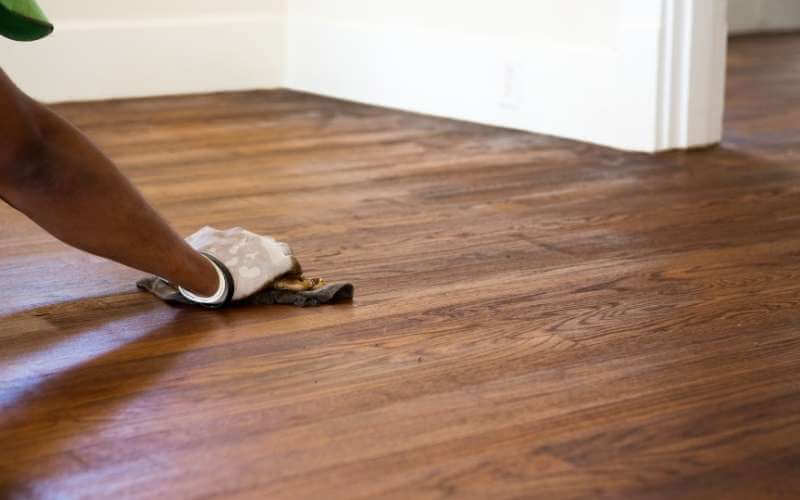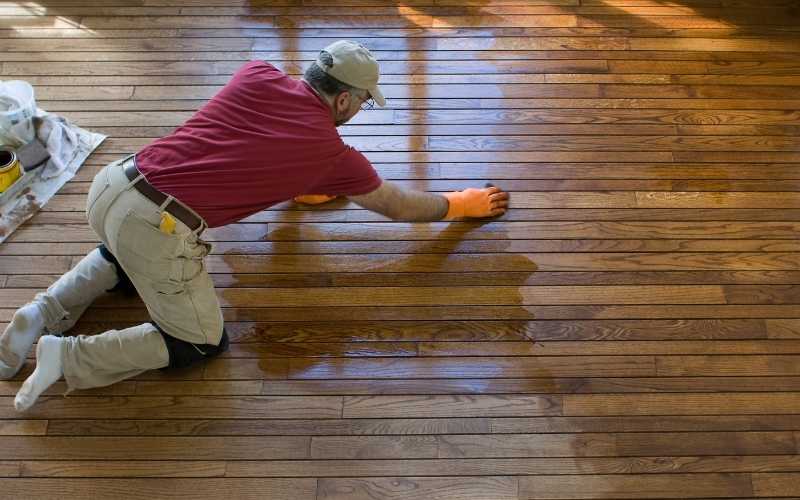If your floors only have a few scratches here and there, you do not have to spend too much to restore them to their original gleen and shine.
So, what is the cheapest way to refinish hardwood floors? The cheapest way to refinish hardwood floors is by applying a revitalizer closely followed by refinishing without sanding.
These chemicals can be bought online or at home improvement stores. Applying a revitalizer is as easy as it can get, with the only step being to apply the solution to a thoroughly clean floor.
Learn more about using a revitalizer and other sanding-free methods to get a smooth, clean hardwood floor.
Related: Best Hardwood Floor Polishes
What Is the Cheapest Way to Refinish Hardwood Floors
Table of Contents
Applying a Revitalizer
Applying a revitalizer gloss is the cheapest way to refinish hardwood floors and is best suited for floors that only have surface-level scratches and other minor damages.
This procedure does not need any special equipment or materials. You would only need a revitalizer gloss which should be applied frequently.
A revitalizer is enough to get your floor looking brand new, and you can purchase them at home improvement stores. These products do not only restore the shine of the dull hardwood but also fill the scratches and add a glossy finish to the floors.
To apply a revitalizer, start by cleaning the floor using water and vinegar to eliminate grime and dust. When mopping your floor, avoid using too much water to avoid damaging your hardwood.
Apply the revitalizer gloss according to packaging instructions and spread the solution evenly using a mop.
Allow the finish to dry completely before returning all the furniture to the room.
Refinishing My Hardwood Floors Without Sanding
You can skip sanding your floor and just move on to refinishing, which is way less tedious. This removes all surface-level scratches and restores the beauty of your floor.
Before you begin to refinish your floor, ensure you know the type of material you are dealing with. To avoid accidentally using the wrong chemical mix, make sure to carry out a test on a small part of the floor and observe the reaction that occurs. If there’s no sign of damage, you can go on with the application.
Read: Dangers of Sanding Wood Floors and Safety Measures to Take
Using a Store-Bought Abrasion Kit
This method involves using a particular chemical that etches the old finish of the floor and enables the cohesion of a new stain coating. This is a less messy approach and does not generate dust.
You can purchase an abrasion kit online or at the nearest home improvement store. They usually come with an easy-to-follow manual to guide you through the process and all the significant materials needed to effectively refinish the hardwood floors.
Clear the room of any furniture, fixtures, and other items that might cause an obstruction.
Apply the liquid abrasive to the hardwood floor and scrub it using the abrasive pad included in the kit. You can attach the pad to a broom handle to make it easier to carry out the application by hand. Allow the product to sit on the floor for as long as it is recommended in the label packaging.
Then rinse out the floor with a gallon of water mixed with two tablespoons of dishwashing liquid. Mop the entire floor with a damp but not dripping wet mop.
Cover up deep scratches still on the floor with a matching stain. Use a rag to blot and blend the colors. Once the stain is dried, apply a thin layer of finishing coat from the kit. This should be applied quickly because the solution dries out immediately, making the finish challenging to smooth out.
When the finish is applied, allow it to dry for at least 24 hours before returning the furniture pieces onto the floor.
Recoating With Polyurethane Solution
Polyurethane coats provide years of protection to your floor, and it may take several years before another refinishing project is required.
Before the polyurethane coating is applied, the floor is lightly sanded with a buffer. This method achieves results that are almost as good as a completely sanded job. You can hire a buffer from a nearby home improvement store.
Just like with the chemical abrasion kit, the surface of the floorboards is roughened up slightly with the buffer to increase adhesion between the floor and the new finish.
Buffing generates lots of dust because it is similar to sanding. So make sure to clear the area of fixtures and furniture pieces and cover the immovable ones with fabric.
If it is your first tim handling a buffer, you can ask for instructions about how to use the tool.
At the onset of the procedure, clean the room (which should be empty) thoroughly. Cleaning the floor exposes all problem areas with striped finish, dents, or deep scratches.
Cover up problem areas with mineral spirits to darken them or stain colors that match the grain of the hardwood.
Remove protruding nails on the floor to prevent them from damaging the buffer. Attach a sanding screen to the buffer and run through the entire perimeter of the floor.
Remember to wear a dust mask while using the buffer as the buffing process creates tons of dust flying around the place. Use a vacuum to clean the room and wipe the floors.
Then apply a coating of the polyurethane finish on the floor. It could either be an oil-based urethane or water-based urethane.
Read: Can You Stain Hardwood Floors Grey?
Conclusion
You can get back the beauty of your scratched out hardwood floor without having to break the bank. Hardwood floors can rake on a beating over time despite their resilience and durability, and their surface becomes overridden with too many scratches or stains.
Refinishing is one way to restore the original appearance of your hardwood floor, and the cheapest way to refinish hardwood floors is by applying a revitalizer. This article also discusses other ways you can refinish your wood floor without sanding.

